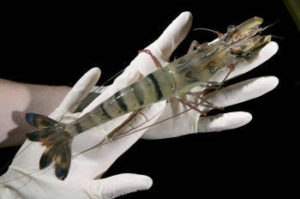RNAi of brood stock to reduce disease impacts in farmed prawns

The Black Tiger Prawn studied in this Science and Industry Endowment Fund sponsored project. (Image: Darren Jew)
The Challenge
In the global prawn industry, pathogens such as viruses are responsible for economic losses of up to US$6 billion per year. Novel antivirals take advantage of a natural biological mechanism called RNA interference (RNAi), and go some way to mitigating these losses. Although not currently yet commercially available, these antivirals have been experimentally demonstrated to protect prawns from disease and mortality of commercial concern.
The Response
Antiviral therapeutics have been developed to protect prawns against viral infections and do not impact the fertility of broodstock. The SIEF Experimental Development Program funding was used to demonstrate that in vitro transcription methods were suitable for producing very large amounts of dsRNA sufficient to undertake commercial-scale evaluation of the RNAi technology.
The Collaboration
An expert team from CSIRO conducted antiviral field trials, with co-investment from the Australian Prawn Farmers Association (APFA), which recognised the immediate commercial relevance of this project. The research team built close relationships with APFA and with industry stakeholders from hatcheries, farms and feed suppliers.
Projected impact
The project has fast-tracked technology commercialisation by establishing unequivocally for the first time that dsRNA is not transferred from female broodstock to their progeny farmed for human consumption. The project outcomes will give commercial prawn farmers the confidence to trial novel RNAi therapeutics at scale, once regulatory approvals are in place, with projected impacts including:
- Substantially improving prawn growth, performance and survival.
- Adding AUD$2.2 million to the $80 million annual Australian prawn industry, improving production efficiency, increasing job growth, and boosting the profitability and international competitiveness of Australian seafood businesses.
- Reducing the US$6 billion disease loss burden on the international prawn farming industry by applying antiviral therapeutics that decrease viral infection loads in up to 500,000 eggs per spawn. The therapeutics would be a source of domestic and international investment, delivering economic value to Australian R&D.
- Producing a consistent, sustainable, high-yield prawn product to secure supplies of a source of healthy protein.
